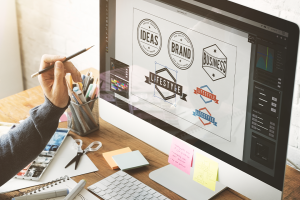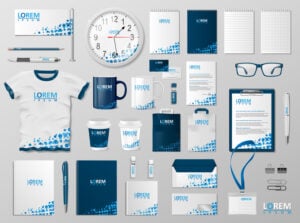It’s virtually impossible to walk out of your house and not be met with an onslaught of logos. They’re everywhere.
Just stop what you’re doing and take a look around your workspace. You can probably easily count two of them just within five seconds of looking, right?
Logos are a part of our every day lives. They represent a brand and their story to the world while also influencing our buying decisions, whether we realize it or not.
But what exactly is the purpose of a logo? What goes into developing them and how do you create a logo that will communicate the right message to your customers?
Read on to find out.
What’s the Purpose of a Logo?
The first and most important role a logo plays in your company’s life is identification. They help your audience recognize, identify, and select your business before anyone else’s. At the end of the day, all the other stuff behind a logo is just white noise in comparison to this one role.
As time moves on, what is considered trendy will change. The tools we use to develop and design things will evolve and grow in new, unexpected ways. And the basics of what we consider a logo might even change.
But at the end of the day, the most important thing that logo, whatever it is, will ever do is identify you, your product, your business, or your service.
Before you work on any ideas you have for your logo, you have to understand everything about your current business environment.
Ask yourself what your competitor’s logos look like. Shop around for the symbols and colors that they use, because those are the ones your target audience will already recognize and trust. How can you make your logo fit in while also standing out?
It’s a Strategy, Not an Art
Logos are a visual representation of your brand, so it would be easy to misunderstand them as art. But they’re not. Logos are meant to be a tool that your business uses for strategy.
You don’t want to simply design something beautiful or something that you find visually appealing. Instead, your logo has to give your audience enough immediate information to identify your company while it swims in the gigantic sea of your competitors.
That doesn’t mean that a logo can’t also look good, of course. But you should consider that factor second after ease of identification.
Hidden Meanings Aren’t Necessary
It’s pretty common for logo designers to try to stuff a logo full of meaning right away. But that’s actually not necessary at all. Instead, keep your focus on the number one target: identification.
As time goes on and your customers come to know and trust your brand, your logo will assign its own meaning. This is because logos are a blank slate and from the minute you put it out in the world, your customers have no idea what it is even if you did fill it with meaning or messages.
But as you market and as customers interact with your brand, that meaning will grow.
Why Are Logos Important?
Logos matter a lot, and here’s why.
They’re Your Brand’s Face
Think about any business at all. Reebok, Ford, anything works. The first thing you think about is probably the logo, right? If you were to design a comic book based on these brands as characters, their logos would literally be their faces.
When you see a logo that you have a history with, you will associate it with those experiences and memories.
Brand Recognition
A good logo provides an instant memory of your brand into a customer’s mind. Simple shapes and colors are the easiest things for people to process, and they’re so much easier to memorize than words.
Because of this, if your logo is a unique, simple image, it’ll stand out from the crowd in the marketplace, making it easy for your customers to find and identify you.
Influence Our Decision Making
The second your customer looks at your logo, whether or not they find it aesthetically pleasing, they are going to start making judgments about it. That one image will change how they see you in some way.
If your customer thinks that your logo is too much of anything, be it fun, expensive, corporate, or radical, they will avoid it. And if the brand and logo look like it will compliment the image they put out in the world, they’ll consider buying it.
You want to encourage your target audience to buy from you. So, by extension, you want your logo to represent you the right way.
Also, from the start, your logo will give your customers expectations of your brand and if you don’t meet them, things will go downhill. It’s so important to get this part of branding right.
First Impression
When it comes to impressing and attracting customers, you have one chance to get it right. If your logo cant draw in onlookers, it’s so easy for people to click away or find something else they jive with more.
Poor logo design can seriously hurt your business’ first impression. If you choose to go the DIY route or save money on an inexpensive designer, you need to understand the risk you’re taking.
Scrimp and save at other points in the branding process, not here. After all, there’s nothing more expensive than a cheap design.
Brand Values and Other Meanings
We’ve hopefully got it stuck in your head that your logo’s one and only mission in the world is to let people identify your business.
But, and this is a small but, you can also use them to communicate specific messages about your brand’s values.
The key here is simplicity. You don’t want to try and shove as much meaning as you can into your logo, that will just overwhelm and confuse your target audience. Stick to one idea and go with that.
Think about the FedEx logo. Did you ever notice the little arrow hidden in the white space between the E and the X? That’s a brilliant way for that company to show that they are speedy and precise.
When you can understand the role of a logo completely, you will create a better image that will perform for your business in every aspect: identification and brand values.
Flexibility
Your logo needs to be simple for a number of reasons. One of the most important is that when they’re simple, they are easily scalable to either very small or very large sizes.
If you make your logo too complex, full of intricate details, you’re going to lose all of those details when you shrink it down.
Think about your logo in terms of where you are going to put it. You’ll want it plastered on your website, all of your ads, your stationery, brochures, signs, marketing swag, and more. It’ll have to translate to a vertical space and a horizontal one.
If you keep it simple, you’ll be able to adjust it to whatever medium you need it to go on.
How to Get a Logo
The best way to ensure that you are happy with your logo and that it achieves success out in the marketplace is to have it made professionally by a designer. There are cheap services for logo design online, but like we said, you get what you pay for.
The best value you will probably be able to find is to source from small, local graphic design shops. This is because you could wind up paying thousands of dollars to a big name agency, but with a small-time graphic designer, you could still get a unique, high-quality logo and personal service to boot.
Tips for Choosing a Logo Designer
Before you select a designer to do your work, make sure that they understand the purpose of a logo as we described it earlier for you. When you’re confident that they understand what you’re asking of them, ask to see their portfolio.
Make sure that you like the work that they’ve done previously. There’s nothing wrong with a designer who’s done work that doesn’t appeal to you visually, it just means that you will probably not see eye to eye on the vision you created for your brand.
Talk with some of the businesses that worked intimately with this designer and figure out if they got the experience that you are looking for in a designer.
Then, make an effort to put a clear, precise image of the kind of thing you want in your logo to take to them. Even if your designer is the best one in the world, if they cant understand the image that you want, you’re both going to walk away unhappy.
A Logo’s Purpose
We’ve said it a few times already and it’s worth repeating. Your logo needs to identify your company before it does anything else. The purpose of a logo is really that simple. Don’t try to over-complicate it with a message or messy details. It’s the face of your brand, after all.
If you want to learn more about the power of a logo, visit us today!







